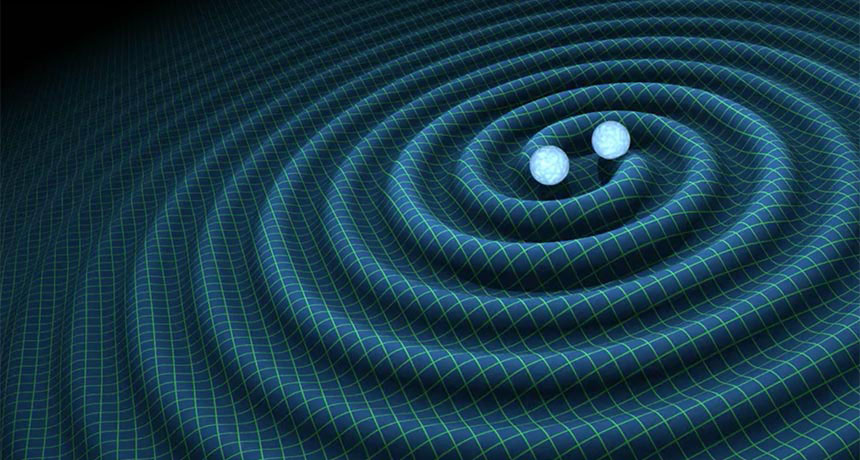Explainer: What are gravitational waves?
Energy from large, dramatic events in space create tiny waves that can ripple past Earth

This is an artist’s rendering of the gravity waves emanating from the movement of massive celestial bodies, such as two black holes.
Caltech/MIT/LIGO Lab
By Christopher Crockett and Andrew Grant
Gravitational waves are ripples in the fabric of space. Throw a rock into a pond and it will create ripples — waves in the water — that appear to stretch and squeeze back again. Similarly, accelerating masses should send gravity waves into space. These ripples would cause space to stretch and squeeze back again.
On February 11, 2016, after decades of trying to directly detect such waves, scientists announced that they appear to have found them. The waves came from another galaxy far, far away. How far? Try between 750 million and 1.86 billion light-years away! There, two black holes collided, shaking the fabric of space and time, or spacetime. Here on Earth, two giant detectors in different parts of the United States quivered as gravity waves washed over them.
In his theory of general relativity, Albert Einstein predicted that ripples in spacetime should radiate energy away from enormously violent events, such as colliding stars. Such events are powerful. Still, the ripples they trigger are subtle. By the time they reach Earth, some compress spacetime by as little as the width of a proton. (A proton is one of the particles that makes up an atom.)
DO THE WAVE After decades trying to directly detect the waves, the recently upgraded Laser Interferometer Gravitational-Wave Observatory, now known as Advanced LIGO, appears to have succeeded, ushering in a new era of astronomy. Science News |
The newfound waves were picked up by the recently upgraded Laser Interferometer Gravitational-wave Observatory. It is now known as “advanced” LIGO. To spot a signal, LIGO uses a special mirror to split a beam of laser light. The mirror sends each beam down one of two 4-kilometer-long tubes. These tubes sit at a 90-degree angle to each other. Light ricochets back and forth 400 times down each tunnel in the detector. This turns each beam’s journey into a 1,600 kilometer (990 mile) roundtrip. Then the light recombines near its source.
The experiment was designed so that under normal conditions the light waves will cancel one another out when they recombine. When that happens, no signal moves on to a nearby detector.
But a gravity wave will stretch one tube while squeezing the other. That alters the distance the two beams travel relative to one another. Make no mistake: The difference is tiny. But it’s enough that when the beams recombine, their waves no longer align perfectly align. Because they no longer cancel each other out, the detector will pick up a faint glow. This signals a passing gravity wave.
To ensure the signal is not triggered by some local phenomenon (and to help scientists triangulate its source), LIGO has two detectors. One is in Louisiana and another is in Washington State. Any signal appearing at only one detector — meaning it’s local — will be ignored.
Scientists initially found gravity waves coming from the collision of two black holes. But those are not the only sources they think they will be able to detect. By working with computer simulations, also known as computer models, scientists can figure out what type of signals to expect from other sources.
A neutron star is the core left behind after a massive star explodes. A spinning neutron star should whip up spacetime at frequencies similar to those produced by colliding black holes.
Powerful explosions known as supernovas are triggered when a massive star dies. They can shake up space and blast the cosmos with a burst of high-frequency gravity waves.
Pairs of gargantuan black holes, each more than 1 million times as massive as the sun — and larger than the ones that Advanced LIGO detected — radiate long, undulating waves. Advanced LIGO can’t detect waves at this frequency. But scientists might spot them by looking for subtle variations in the steady beats of pulsars. Pulsars are spinning, ultra-dense neutron stars.
The Big Bang might have triggered universe-sized gravitational waves 13.8 billion years ago. These waves would have left an imprint on the first light released into the cosmos 380,000 years later. Scientists now are looking for these waves today in the cosmic microwave background. That’s the radiation left behind from the Big Bang.







